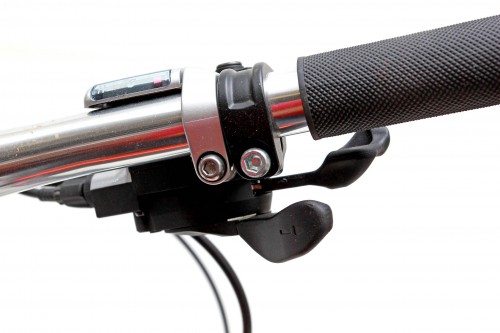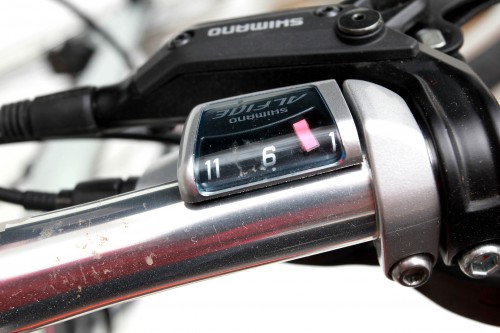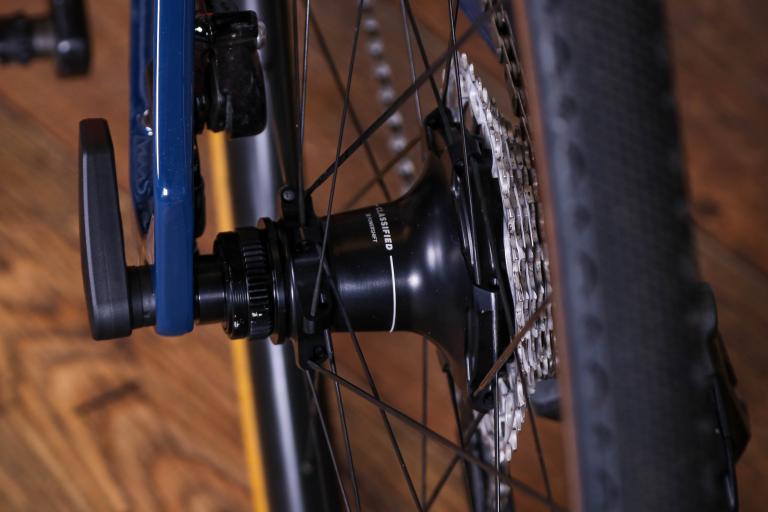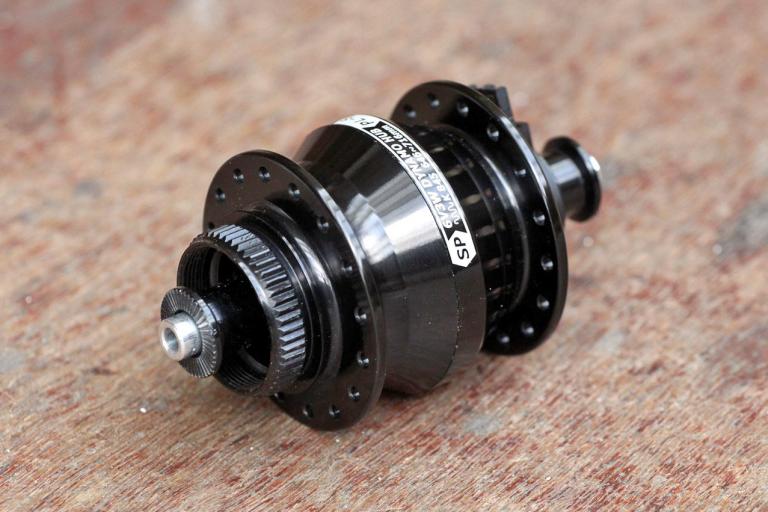- News
- Reviews
- Bikes
- Accessories
- Accessories - misc
- Computer mounts
- Bags
- Bar ends
- Bike bags & cases
- Bottle cages
- Bottles
- Cameras
- Car racks
- Child seats
- Computers
- Glasses
- GPS units
- Helmets
- Lights - front
- Lights - rear
- Lights - sets
- Locks
- Mirrors
- Mudguards
- Racks
- Pumps & CO2 inflators
- Puncture kits
- Reflectives
- Smart watches
- Stands and racks
- Trailers
- Clothing
- Components
- Bar tape & grips
- Bottom brackets
- Brake & gear cables
- Brake & STI levers
- Brake pads & spares
- Brakes
- Cassettes & freewheels
- Chains
- Chainsets & chainrings
- Derailleurs - front
- Derailleurs - rear
- Forks
- Gear levers & shifters
- Groupsets
- Handlebars & extensions
- Headsets
- Hubs
- Inner tubes
- Pedals
- Quick releases & skewers
- Saddles
- Seatposts
- Stems
- Wheels
- Tyres
- Health, fitness and nutrition
- Tools and workshop
- Miscellaneous
- Cross country mountain bikes
- Tubeless valves
- Buyers Guides
- Features
- Forum
- Recommends
- Podcast
review
£429.99
VERDICT:
Takes high end hub gear performance into affordable territory
Weight:
1,744g
Contact:
www.madison.co.uk
At road.cc every product is thoroughly tested for as long as it takes to get a proper insight into how well it works. Our reviewers are experienced cyclists that we trust to be objective. While we strive to ensure that opinions expressed are backed up by facts, reviews are by their nature an informed opinion, not a definitive verdict. We don't intentionally try to break anything (except locks) but we do try to look for weak points in any design. The overall score is not just an average of the other scores: it reflects both a product's function and value – with value determined by how a product compares with items of similar spec, quality, and price.
What the road.cc scores meanGood scores are more common than bad, because fortunately good products are more common than bad.
- Exceptional
- Excellent
- Very Good
- Good
- Quite good
- Average
- Not so good
- Poor
- Bad
- Appalling
We first got to try out Shimano Alfine 11 earlier this year but since then there's been much talk and an awful lot of waiting around, but we've finally managed to get a proper go on Shimano's new Alfine 11 hub. A second sample is winging its way to us from Japan so that we can ride it longer term but we're sure you're wondering what we think of it, so here goes: we think it's really good.
Unless you missed the launch of Alfine 11 earlier in the year, let's have a recap. Essentially the 11-speed hub is an entirely new beast, it doesn't really have anything in common with the eight-speed unit that shares the same name. The headline change is the bigger range of gears for a wider spread, but the most important revision is behind the scenes. The new hub is a helical system using oil bath internals, rather than greased cogs. Yes, like the Rohloff Speedhub. This should mean two things. Firstly, maintenance is massively simplified. There's an oil port on the hub body which allows you to suck the used lubricant out and replace it without having to take the whole thing to pieces. Secondly, it should extend the service life of the hub into the kind of mileage where it's unlikely to ever be an issue; Shimano told us at the launch that it should run for three times as long as the eight. The stated weight is now 1590g, which is 90g lighter than Shimano's weight for an Alfine 8 and less than a Speedhub too. However, we've now received a second boxed hub to go with our built up one and straight out of the box it tips the scales at 1744g, a fair whack heavier than list. The shifter and cabling bump the overall system weight up to a whisker under 2kg.

We didn't fit our hub to the bike as it came already fitted, so we can't comment directly on the fitting process (we will be fitting one to another bike and we will comment on the process in more detail then) but it uses similar non-turn washers as the eight-speed unit and doesn't require any special dropouts. You'll need to keep the chain under tension, of course; our Charge Mixer had an eccentric bottom bracket for that purpose but you could use a chain tensioner if you're retrofitting to a standard frame. The control cable runs along the chainstay and up to a redesigned shifter. Anyone that's used Alfine 8 will have gone through the learning process of having to use the back-to-front thumbshifter, but now you're going to have to unlearn that, as the new unit is configured the same as derailleur units. It also has a two-ratio sweep (both up and down), and two-way release on the downshift so you can push the lever with your thumb as well as pull with your finger. The only minor downside to the shifter redesign is that a broken cable puts you in the big gear rather than the little one, but it is a minor issue.
So to riding. The first thing that became immediately obvious when riding the hub for real is that the ratios aren't all linear like we assumed. We asked Shimano for the ratio chart which backs up what our riding experience tells us: there's a big jump from first to second, and after that it's much more even. Here's the gain ratios chart in full:
1: 0.527
2: 0.681
3: 0.770
4: 0.878
5: 0.995
6: 1.134
7: 1.292
8: 1.462
9: 1.667
10: 1.888
11: 2.153
This gives an overall range of 408.5%, with a 24% jump from first to second followed by 13%-14% steps for the rest of the gears. This gives you first as a useful bail-out gear if things get too tough, and the rest of the time you're switching between ratios that are about the equivalent of a larger jump on a derailleur block, say from a 21 to a 24. They're larger gaps than you'll be used to if you're coming from a derailleur transmission but it doesn't take long to get used to.
Hub gears normally have a couple of ratios that feel more vague than the others, and this one is no exception. It's the shorter gears that feel slightly woolly, with 2nd and 3rd being the worst offenders; first is fine. That being said, there's no one gear that we ended up avoiding and it's certainly no worse than the eight speed or even the Rohloff. Once you get up into the cruising ratios the hub feels more direct.
The range is enough to give you a really good spread of gears, enough for pretty much anything. If you're fitting the hub to a tourer then you'll probably want to sacrifice some big gears for more winching ratios at the other end; the same is probably true for mountain biking whereas for an urban bike you can afford to give yourself a few more gears for speed. By way of a comparison the range available is similar to what you'd get from a compact double or a road triple; it's not quite in MTB triple or Rohloff territory but with a judicious choice of chainring and sprocket you can easily tailor the gears to the type of riding you're doing.

The shifter works very well and requires minimal adjustment. Obviously it's good to be able to shift while stationary for an easy getaway at the lights, and the two-ratio sweep is handy if you find yourself caught out by a sharp hill. The feel of the shifter isn't as consistent as a derailleur shifter; sometimes the shift is a bit industrial although it hasn't missed a shift thus far. Also, with some ratios you need to back off the power just a touch to give the gears a chance to shift, like you do with the Alfine 8. As far as actual riding is concerned this is the only downside over a Rohloff, which is indexed internally and doesn't seem to suffer from that problem. Again, it's a skill you need to learn.
So then, who's going to be in the queue to get one? Urban riders, for sure. It's no coincidence that our first Alfine 11 test rig was an urban bike because it ticks the boxes for city riding: low maintenance, clean lines. Alfine 8 has had a small but dedicated following in MTB circles too and the new hub will certainly broaden that appeal; the extended range and hardier internals will mean more off-road converts; the extra wheel mass is not so much of an issue on the rough stuff.

For now the fact that it's a flat bar shifter narrows the appeal for roadies, but assuming that issue gets addressed – Jtek are no doubt working on their bar end shifter right now, and someone will have an STI-style lever in the pipeline – is it a viable option for a road bike? Well, it depends. If you're into your touring then the Alfine 11 makes a whole lot of sense; a good range of enclosed, maintenance-free gears that you can fit to a standard frame. At an RRP of £430 for hub and shifter it's well below Rohloff prices, and a quick search online shows that you can expect to get another £100 off that when they finally land at the shops.
Move from touring up to faster Audax riding and it's a maybe. Our hub came bolted to a Charge Mixer that's fairly swift but not designed for prolonged journeys; the limiting factor for ride length was on-bike comfort rather than the hub itself. At over 1700g it's still a lot of rotating mass to add to a bike though, so until we've had a go with one built into a lightweight wheel and set in a lightweight frame it's hard to judge whether the benefits outweigh the penalites. Our gut feeling is that the longer the ride, the more sense the Alfine 11 would make.
And road riding and sportives? Probably not. While the system itself isn't any heavier than derailleur gears we can't see it really making any inroads into lightweight road bikes because of the rotating mass issue, and the not-efficient-enough stigma will remain, even though the differences are fairly marginal these days. Were the concept of enclosed gears applied to the frame rather than the rear hub, that might be a different story...
Verdict
Alfine 11 sets the bar higher for affordable hub gears, but it's not quite ready for the switch to fast road riding
road.cc test report
Make and model: Shimano Alfine 11 hub gear and shifter
Size tested: Silver
Tell us what the product is for, and who it's aimed at. What do the manufacturers say about it? How does that compare to your own feelings about it?
# The Alfine 11-speed internal gear hub runs on needle bearings for increased durability and high drive efficiency
# Helical internal sprockets increase durability, perform better with high torque loading and provide a constant engagement for a smooth and quiet operation
# Oil bath lubrication system increases durability and reduces friction in the hub, while Labyrinth seals improve sealing performance both resulting in extending service life
# Silent clutch engagement also gives a smoother quieter shift
# Shimano's precise manufacturing abilities have enabled them to construct the Alfine 11-speed internal hub to be there most efficient yet
Rate the product for quality of construction:
8/10
Very well made and all the development work is toward a much more reliable and low-maintenance unit
Rate the product for performance:
8/10
Great range of gears, good feel, precise shifting. A couple of ratios are a bit vague, a few shifts are a bit industrial
Rate the product for durability:
9/10
Should last for ages, no problems with our test unit
Rate the product for weight, if applicable:
7/10
Lighter than the eight, and lighter than the Rohloff, but still a big rotating mass
Rate the product for comfort, if applicable:
7/10
Easy to use, reliable and ergonomic shifter
Rate the product for value:
8/10
Not cheap, but the extra money is worth it for the better build
Tell us how the product performed overall when used for its designed purpose
Very well, a great enclosed gear system
Tell us what you particularly liked about the product
The range of gears, the improved shifter, the ease of maintenance
Tell us what you particularly disliked about the product
Still a couple of vague ratios, shifter feel a bit incosistent
Did you enjoy using the product? Yes
Would you consider buying the product? On the right bike, yes
Would you recommend the product to a friend? Yes
Anything further to say about the product in conclusion?
The Alfine 11 is a definite step forward and should be applauded. It's not perfect, but it will have wide-ranging appeal.
About the tester
Age: 38 Height: 190cm Weight: 98kg
I usually ride: whatever I'm testing... My best bike is: Genesis Equilibrium with SRAM Apex
I've been riding for: 10-20 years I ride: Every day I would class myself as: Experienced
I regularly do the following types of riding: time trialling, cyclo cross, commuting, sportives, general fitness riding, fixed/singlespeed, mtb, Mountain Bike Bog Snorkelling, track
Dave is a founding father of road.cc, having previously worked on Cycling Plus and What Mountain Bike magazines back in the day. He also writes about e-bikes for our sister publication ebiketips. He's won three mountain bike bog snorkelling World Championships, and races at the back of the third cats.
Latest Comments
- dh700 1 sec ago
It is a silly waste of time to make these generalizations at the same one is trying to apply specific category labels to bicycles -- especially...
- Sredlums 4 hours 6 min ago
Maybe the UK could try to reach some sort of agreement with the EU over things like international trade and such.
- David9694 4 hours 36 min ago
Cumbria County Council was a 1974 creation, merging the of old County Borough of Carlisle, and counties of Cumberland, and Westmorland - in which...
- Backladder 4 hours 48 min ago
If BC want to insist on barriers then they should have their own stock loaded on a truck that they can rent out to organisers at reasonable cost,...
- Miller 5 hours 18 min ago
Well, there's lifetime bans and there's lifetime bans. Banning an 88 year old don't impress me much.
- Gkam84 8 hours 23 min ago
I think that is why blind eyes have been turned in the UK, internationally aswell, with things like the Redhook crits, there were many licensed...
- mdavidford 9 hours 32 min ago
Ahem - other esporters(?) might be rather surprised to hear that the UCI has taken over their events - I think that would be the Cycling Esports...
- Bungle_52 9 hours 41 min ago
I wonder how he got to the game?
- OldRidgeback 9 hours 44 min ago
You'd need some good wet weather gear for that ride too.
- OnYerBike 12 hours 8 min ago
It seems to me that the most likely explanation is that whoever provided that quote fails to grasp the difference between a "public right of way"...








Add new comment
21 comments